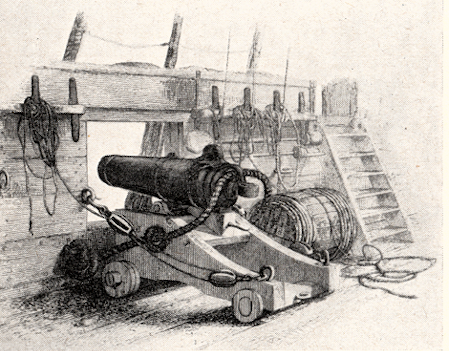

![]()
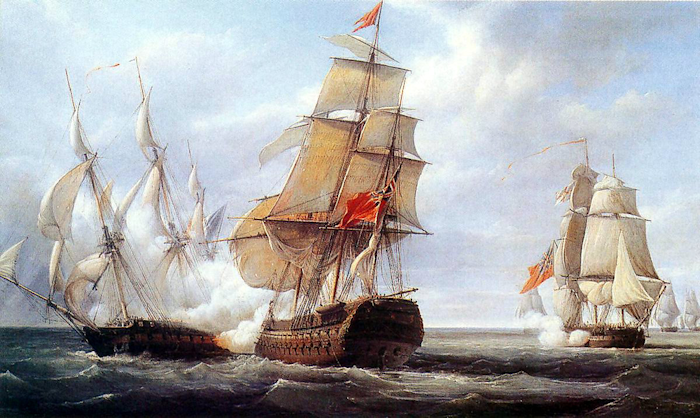

SCARBOROUGH Ketch 10 gun, 94bm, Built Scarborough by John Frame 1690/91.
1691 Commissioned.
1693 Captured by two French privateers, the 20 gun Le Saint-Antoine and the 18gun La Marianne in the Irish Sea.
1694 Retaken by HMS York and HMS Dover.
Did not re-enter service with the Royal Navy but sold on. Eight similar ships of this type were built around the same time for coastal and
convoy duties but were found to be susceptible to capture by the French due their small size and fire power.
SCARBOROUGH 5th Rate 32 gun, 374bm, 105 x 29ft. Built Woolwich Dockyard, Master Shipwright Joseph Lawrence 1693/94.
January 1694 Commissioned.
18.7.1694 Captured by two French privateers, the 36 gun Le Comte de Revel and the 22 gunL'Etoile off Tory Island, Northern Ireland. 32 crew killed including the Captain (Thomas Killingworth) and 10 wounded. Taken into French service and renamed as the Duc De Chaulnes.
15.2.1696 Recaptured by HMS Plymouth and HMS Rye. Renamed HMS Milford.
SCARBOROUGH 5th Rate 32 gun, 391bm, 108 x 28.5ft. Built Southampton, James Parker,
1696 Commissioned.
20.7.1696 Took French privateer La Volontaire.
1697 - 1702 West Indies,
1702 - 1707 East Indies,
1707 - 1710 West Indies.
21.10.1710 Captured by a 30 gun French privateer off Cape Lobos, on coast of Guinea; re-named Le Scarborough.
31.3.1712 Recaptured by HMS Anglesea and HMS Fowey. Renamed HMS Garland and after extensive service in the Baltic and Mediterranean as a fire-ship; broken up 24.10.1721 at Sheerness.
SCARBOROUGH 5th Rate 32 gun, 416bm, 108 x 29.5ft. Built Sheerness Dockyard,
1711 Commissioned.
1711 Russian Convoys,
1712 - 1713 West Indies,
1714 - 1715 Sheerness Guard Ship and repairs,
1716 - 1718 West Indies. Alleged action against 'Black Beard' (Edward Teach)and the 18 gun Queen Anne's Revenge off the island of St. Vincent 1718 (unproven).
21.10.1720 Deptford to be broken up but re-built 1722 as a 6th Rate. (See below).
SCARBOROUGH 6th Rate 20 gun, 375bm, 106 x 28.5ft. Built Deptford Dockyard, Master Shipwright Richard Stacey 1720/24.
1724 - 1728 Captain George Anson. Carolina, North America Station.
HMS Scarborough was an important part of what became an illustrious career in the Royal Navy. Most famously known for his South American
exploits whilst Commodore in HMS Centurion, eventually becoming an Admiral of the fleet and First Lord of the Admiralty.
1728 Repair and refit Plymouth,
1729 - 1731 Leeward Islands,
1731 - 1732 Repairs Plymouth,
1732 - 1736 North America.
25.8.1739 Sold at Deptford for £225.
SCARBOROUGH (Ex Merchant Ship) 18 gun, 501bm, 116ft x 31ft.Purchased 1739 from Mr. Raymond as store ship. Fitted out as Hospital ship
at Woolwich.
1740 Commissioned.
1741 - 1743 West Indies, present at Cartagena and Santiago operations.
18.12.1744 Sold Deptford.
SCARBOROUGH 6th Rate 20/24 gun, 442bm, 106 x 31ft.Builder Philemon Perry, 1739 - 1740 Blackwall.
1740 Commissioned Woolwich Dockyard.
1740 - 1744 West Indies, present at La Guaira and
PuertoCabello.
1744 - 1745 Repair and refit Sheerness.
1745 Recommissioned for North sea and Scottish coast service with Admiral Byng's squadron.
1747 Convoy service.
1749 Sold at Woolwich.
SCARBOROUGH 6th Rate 20/22 gun, 433bm, 107.5 x 30.5ft.Builder Hugh Blaydes, Hull, 1755 - 1756.
1756 Commissioned at Portsmouth.
1756 - 1757 The Downs and Channel cruising.
September 1757 Sailed for North America,
16.1.1758 took (with HMS Juno) the 34 gun Frenchman L'Echo).
Present at: Louisbourg 1758 and
Quebec 1759.
Then with Vice Admiral John Byron's squadron at Louisbourg 1760 at destruction of 32gun Le Machault,
22 gun Le Bienfaisant and 16 gunLe Marquis de Marloze in Chaleur Bay.
29.7.1761 Surveyed.
1761 Recommissioned April.
1761 North America,
1762 Home waters.
1762 - 1764 North America and the Leeward Islands.
1764 Paid off and Surveyed.
1765 - 1767 at Deptford, large repairs and fitting out.
1766 Recommissioned.
1767 - 1772 Leeward Islands.
1772 Surveyed and repaired at Sheerness August,
1773 - 1774 Refitted Chatham.
1774 Recommissioned.
1774 - 1778 North America.
During which the rescue by HMS Scarborough in 1776 of Sir James Wright, the last British Governor of the Colony of Georgia took place.
The daily logs from 8 December 1775 to 31 May 1776 kept by the ship's captain, Andrew Barkley, and the ship's master, James Turner, during
the period when the then British Governor of Georgia, Sir James Wright, escaped from Savannah, are located at the Public Record Office, Kew,
London. Included are the day to day incidents of the ship's passage to Halifax, Nova Scotia via Rhode Island and Cape Cod, Massachusetts.
The ship's log records; the details of the fighting engagements that the ship took part in, reconnoitering activities, stores and provisions
taken onboard, weather and sea conditions, as well as the reading of the Articles of War to the ship's company. Also included are muster
records which document a detachment of soldiers coming onboard on 26 December 1775 and, again in February 1776, for the protection of the
Governor.
1779 Refitted and copper bottomed Chatham.
1779 Recommissioned.
English Channel then Leeward Islands and to Jamaica 1780 with Admiral Rodney's fleet.
Lost presumed foundered with all hands off San Domingo in the Great Hurricane 5.10.1780.
SCARBOROUGH 3rd Rate 74, 1,745bm, 176 x 48.5ft. Draught 13ft 3in/17ft 6in. Builders Graham, Harwich, 29.3.1812. Commissioned February 1813 under Captain John Halstead, as flagship of Rear Admiral John Ferrier in the North Sea. 1814 Captain Charles James Johnson. Laid up October 1817 after middling repairs at Woolwich costing £24,215 and sold Deptford 3.9.1836 for £6,000.
COUNTESS OF SCARBOROUGH Hired November 1777 - Captain Thomas Piercy. 20 Guns.
17 June 1779 Countess of Scarborough and
Medea took the French privateers Due de la Vauguyon and Comte de Maurepas.
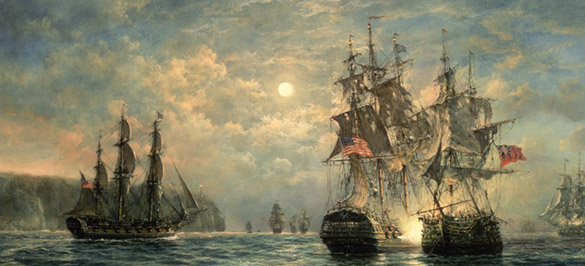
23 September 1779 Countess of Scarborough taken by the French 26 gun Pallas, part of a combined French and American squadron commanded by John Paul Jones off Flamborough Head. Part of an historical document provided by the Royal Navy National Museum Portsmouth mentioning the taking of the Countess of Scarborough can be seen by visiting this historical documents page.
SCARBOROUGH Convict transport ship of 430 tons, built at Scarborough in 1782.
She formed part of the First Fleet, which commenced the European settlement of Australia in 1788. Further details can be found at
the First Fleet Fellowship website page.
SCARBOROUGH 3rd Rate 74 gun, 1,745bm, 176 x 48.5ft. Graham, Harwich, 29.3.1812. Flagship of Rear Admiral John Ferrier on the North Sea station. 1814 Fitted for ordinary at Sheerness. 1817 laid up at Sheerness and roofed over fore and aft. September 1836 sold at Deptford.
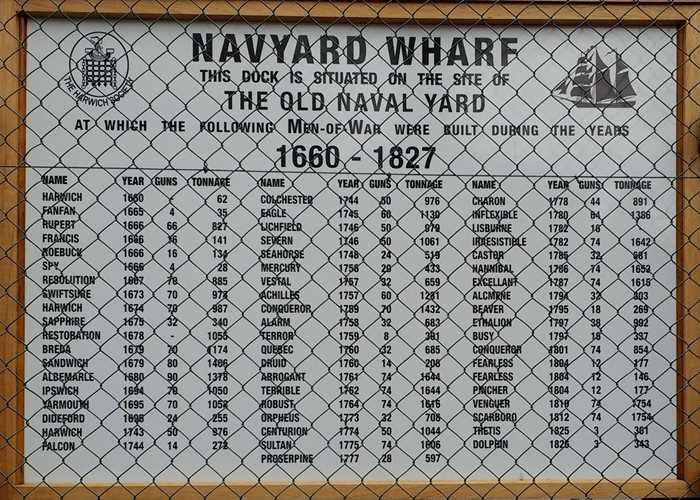
Three historical documents relating to the management of the 18th century HMS Scarborough 6th rate ships can be seen on this historical documents page. The documents are from the Royal Navy National Museum Portsmouth and are protected by the RNNM Copyright. The first two documents I believe refer to appointments of Captains to HMS Scarborough. In the second document there is reference to the 'taken' (capture) of the Scarborough by a 30 gun French privateer off Cape Lobos, on the coast of Guinea and re-named 'Le Scarborough' in October 1710. The third document refers to the warrant addressed to the Clerk of the Cheque, Portsmouth, for the fitting out and manning of the Gosport and Scarborough 9th January 1700.

|
|
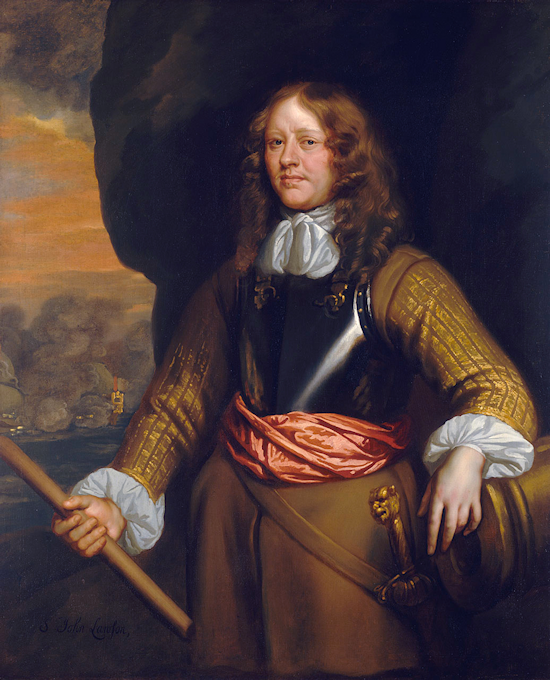
Of his early life scarcely anything is known. Born at Scarborough in the North Riding of Yorkshire of poor parents, he was sent to sea at an early age, and after acquiring a complete knowledge of his profession, he quitted the merchant service and entered the Royal Navy as a common sailor about the time that Hull was seized for the Parliament. In this situation his conduct was so excellent that the officers of the ship noticed him for his industry and sobriety. Although destitute of friends and interest, he was advanced on account of his extraordinary merit. (See "Lloyd's Lives of Excellent Persons".)
Lawson was associated with Blake, Cromwell, Monk and Montagne in all the political struggles of the commonwealth and the restoration. In the famous fight between the English and Dutch fleets early in the year 1653 near Cape Hogue, which continued for three successive days, Captain Lawson had the command of the Fairfax, and his ship was wretchedly shattered. In the second engagement, he boarded one of the Dutch ships of war and brought her off. On the third day, as the Dutch endeavoured to escape among the shallows, Captains Lawson, Marton and Graves followed them so boldly that each took a Dutch man-of-war; for his behaviour in this action after the fight, Sir John Lawson was promoted to the rank of Rear-Admiral. Later on in the month of June, in another engagement with the Dutch, The English fleet was commanded by Monk and Dean, and assisted by Vice-Admirals Penn and Rear-Admiral Lawson, the latter laid his ship alongside the Dutch admiral, and sunk a ship of 42 guns. At the latter end of July, for the third time in the same year, he was engaged in a fight with the Dutch, and singled out his old antagonist De Ruyter, whose ship he so disabled that it was towed out of the fleet. Twenty-six ships of war were either burnt or sunk.
The Parliament, in approval, ordered gold chains to be sent to General Blake and Monk, and likewise to Vice-Admirals Penn and Rear-Admiral Lawson. The late Col. Richard Norton, of Southwark, Hampshire, grandson of Sir John Lawson, had his grandfather's gold chain and medal in his possession, which he left to Mr Richard Crichley. (Grainger's Biography, vol.1 p. 161)
The next step in Mr Lawson's career was an appointment to command a fleet of 44 sail which was sent over to Holland, and took a number of prizes, which service had great influence in bringing about a peace.
In April, 1657, on Cromwell's assuming the supreme power to himself, and a change of government taking place, Sir John Lawson was continued in command and treated with very much respect; but being dissatisfied with the Protector's policy, he became one of a committee to confer with a formidable body of men, chiefly discontented officers in the army, styled "fifth monarchy men"; but their proceedings being revealed to Secretary Thurlow, Major-General Harrison, Rear-Admiral, Lawson, and several others were committed to prison.
When he recovered his liberty he went into retirement, most probably to his house at Scarborough, as the corporation rent roll shews that in 1658 he farmed some fields called the Garlands, belonging to the bailiffs and burgesses. Indeed, Scarborough seems to have been his constant residence when released from the arduous duties of his station.
On the return of Admiral Montagne with the fleet from the Baltic, the Parliament sent for Mr Lawson and declared him Vice-Admiral, ordering him to take charge of the whole fleet; this he did, and when Monk had matured his plans for the restoration of the ancient constitution, Admiral Lawson concurred therein, and the navy followed the example of their commander.
Clarendon says in politics Sir John Lawson was Republican, and being commander of the fleet when Richard Cromwell was thrown out, he brought the whole fleet into the river, and declared for that which was called the Parliament, which entirely frustrated other designs, though he only intended the better settlement of the commonwealth.
At the breaking out of the Dutch war he returned home, the king having sent for him to serve under the Duke of York, as Rear-Admiral of the Red. In all things relative to the fleet, His Royal Highness the Duke of York consulted daily for his own information and instruction with Sir John Lawson, Sir George Ayscue, and Sir William Penn, all men of great experience in naval affairs, and who had commanded in several engagements; but Sir John Lawson was the man of whose judgement the Duke had the most esteem, though in his manners he retained much of the bluntness and roughness of the tarpaulin. (Grainger)
After the restoration, Sir John Lawson had the honour of knighthood conferred upon him by King Charles; and to the end of his life conducted himself with great judgement and spirit in several engagements, and was never for any length of time out of actual service. He came very early and very heartily into the restoration, and was sent as Vice-Admiral to the Earl of Sandwich to bring Queen Catherine from Portugal, so that when the Earl acknowledged his services to the King of Holland, he was much commended and was always looked upon as a man sincerely attached to the crown; which was confirmed by all his succeeding actions.
He was also appointed one of the commissioners of the Navy Board at the recommendation of the Duke of York, and received £500 a year for his services. Subsequently he was employed in the Mediterranean against the Algerines, and so effectually blocked up their ports that they were unable to send out their cruisers and had to sue for peace. He had been in all the actions performed by Blake, and in all the battles Cromwell fought with the Dutch, in which latter he was a signal officer and very much esteemed by him; and now he was to fight his last battle on the element he loved so well, and the 3rd June 1665, after exceeding all he had done before, he received a shot in the knee by a musket ball which proved fatal. The wound was not considered mortal, and he was sent on shore as far as Greenwich, where for some days there was hope of his recovery, but shortly the wound gangrened, and so he died with great courage and profession of an entire duty and fidelity to the king. (Clarendon) Prior to this last engagement, he seems to have had a presentiment of his death and in "Cambell's Lives of the Admirals" there is a very interesting and touching letter on the subject.
Sir John Lawson was a member of the Corporation of Scarborough for many years, but from his unavoidable absence from the borough, chiefly an honorary one, ranking with the "first 12". In religious profession he was an Independent. The house in which he first lived was situated at the lower end of what was Merchants Row, now Eastboro', afterwards pulled down by the present Gas Company of the town. (Some things never change - Webmaster)
1662, Oct 5th, Charles II, - Articles of peace between his sacred Majesty, Charles II, King of Britain, &c., and the Most Excellent Seignor Mahomet Bassa, the Duan of the most noble city of Tunis, Hodgie Mustafa Digi, Mahomet Bye, and the rest of the soldiers in the kingdom of Tunis, concluded by Sir John Lawson. (Harl. Miscell.)
*See Pepy's Diary for several mentions of him.** A new and long overdue biography written by Gill Blanchard of Vice Admiral Sir John Lawson can be purchased online at https://wordery.com/search?term=Gill+Blanchard
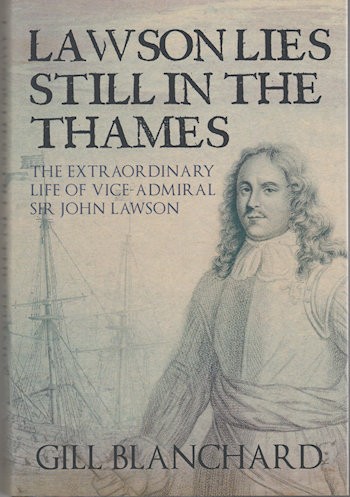
Our Captain Philips didn't drive a giant container ship, or be threatened by Somali pirates in outboard motor powered skiffs but was Captain of a small Royal Navy sloop HMS Bonetta, escorting British and friendly nation merchant ships to and from the near continent and Baltic States, during the Napoleonic wars of 1803 - 1815.
He was described as a native of Scarborough and the son of Alexander Philips, Master, Royal Navy.
James entered the Navy on the 4th of October 1785 as an able bodied seaman, so we must assume he had already acquired
seamanship knowledge and skills before joining the Royal Navy.
His first two years at sea were with Captain Israel Pellew who later took part in the battle of Trafalgar and was known by Nelson as one of his "band of brothers". On leaving Captain Pellew's ship HMS Resolution, James served in a number of frigates and ships of the line on the Home and West Indies Station including his father's ship HMS Camel (A store ship) the equivalent of a Royal Fleet Auxiliary today.
He must have been educated and numerate as he was commissioned as Lieutenant aboard HMS Majestic in the West Indies on the 10th of December 1795, ten years after joining as an able seaman. Previously as a Midshipman in 1794 he had taken part in the desperate defence of Fort Matilda, under siege by the French on the Island of Guadeloupe and in 1796 the re-capture of St. Lucia.
On return to home waters in HMS Beaulieu he took part in the battle of Camperdown under Admiral Adam Duncan against the Dutch Vice admiral Jan de Winter's fleet. The result of the battle was an overwhelming victory for the Royal Navy and Lieutenant Philips was sent to the Dutch 40 gun prize ship Monnikendam which unfortunately went ashore on the sands of West Capel resulting in James' capture by the enemy and some time in captivity!
On restoration of his liberty he rejoined HMS Beaulieu and then served in several other ships before joining HMS Centurion (50 guns) as 1st Lieutenant, on the India station and where James had arguably his finest moment, when without his captain onboard at the commencement of the action, he fought off a French attack in the Vizagapatam roads in September 1804 by a squadron of French warships lead by Rear Admiral Charles Alexandre Durand Linois in the FRS Marengo (80 guns) and two 40 gun frigates. There is no doubt that the recommendations to the Admiralty by his grateful captain regarding the actions he took until his captain could rejoin the ship would have assisted his promotion to Commander on the 15th March 1805.
May 1806 saw him back in the United Kingdom appointed in command of the 14 gun sloop HMS Bonetta but he was unable to take up immediate command of the Bonetta as she was at sea on North Sea convoy duties, so in the meantime he took command of the Brig Sloop HMS Gannet until the Bonetta returned, when he was employed during the remainder of the year escorting merchantmen to and from the German rivers, and in 1807 in affording protection to the trade in the Baltic; where he took part in the operations at Copenhagen.
He attained Post-rank (Captain) on 13 Oct. 1807 and at the end of 1807 following his return from Copenhagen was given no further appointments and placed on half-pay. His promotion to Flag-rank (Rear Admiral) took place on the 23rd of November 1841 but he never went to sea with the Royal Navy again, dying at his home in Plymouth, Devon, in 1852.
His younger brother, John Alexander Philips, also joined the Navy and first served as a midshipman in HMS Bellisle at the Battle of Trafalgar on 21 Oct 1805, later transferring to the Royal Marines Artillery in 1806. Prior to joining the Royal Marines he served as Master's Mate in his brother's ship HMS Bonetta. He later took part in actions in the Mediterranean, and on the coast of Spain. Also in the American War of 1812. He finished his service career as Major General at Woolwich. He died on 27 November 1865 in Hampshire.
What an incredible time for the brothers and their father to have served in the Royal Navy.
Following is an extract from the publication compiled by Lieutenant John Marshall RN and published in 1824. A biography of all the flag officers, superannuated rear admirals, retired captains, post captains and commanders whose names appeared on the Admiralty list of sea officers at the commencement of the late year, or who have since been promoted; illustrated by a series of historical and explanatory notes, which will be found to contain an account of all the naval actions and other important events from the commencement of the late reign in 1760 to the present period.
JOHN KENDALL, Esq.
This officer accompanied the Hon. Captain Byron, in the Dolphin, of 20 guns, on a voyage of discovery round the world,
which was completed in twenty-two months and six days. He subsequently served under the same commander on the coast of North
America, where he was promoted to the rank of Post-Captain, Nov. 24, 1778; since which time, we believe, he has not been
afloat. His superannuation as a Rear-Admiral, took place July 3, 1795. Residence. - Scarborough.
On the 3rd July, 1764, the Dolphin, of 20 guns, commanded by the Hon John Byron, and the Tamar sloop of war, Captain Patrick Mouat, sailed from Plymouth, on a voyage of discovery and on the 14th Jan. 1765, being in the lat. of 51° S., and long. 63° 22' W., some small islands were discovered, in one of which was found a most excellent harbour, where the ships anchored. Captain Byron, in compliment to the first Lord of the Admiralty, gave it the name of Port Egmont. These islands were surveyed, and taken possession of for Great Britain, by the name of Falkland's Islands. From hence the ships proceeded into the Pacific, and pursued their course to the N. W. On the 7th June, in lat. 14° 5' S., long. 144° 58' W., a cluster of small islands was discovered, but every part of their coasts found to be inaccessible, being bounded by stupendous rocks, on which a most violent surf constantly broke. The first of these islands Captain Byron named after his sovereign; the others were named Prince of Wales's Island, Duke of York's Island, and the Islands of Danger. On the 2d July, in lat. 1°18' S., long. 173° 46' W., another island was discovered, which the officers of the expedition, in compliment to their Commodore, named Byron's Island. From the latter they steered for Tinian, and from thence to Batavia, the Cape of Good Hope, and England. They anchored in the Downs, May 9, 1766.
References:
http://www.ageofnelson.org/MichaelPhillips/index.html
Royal Naval Biography; (Various Volumes) John Marshall
Post Captains of 1807 - John Marshall
Wikipedia - Various References to Persons, ships, and actions.
The Gentleman's Magazine - 1852 - Sylvanus Urbam (Gent)
Obituary of Rear Admiral James Robert Philips
